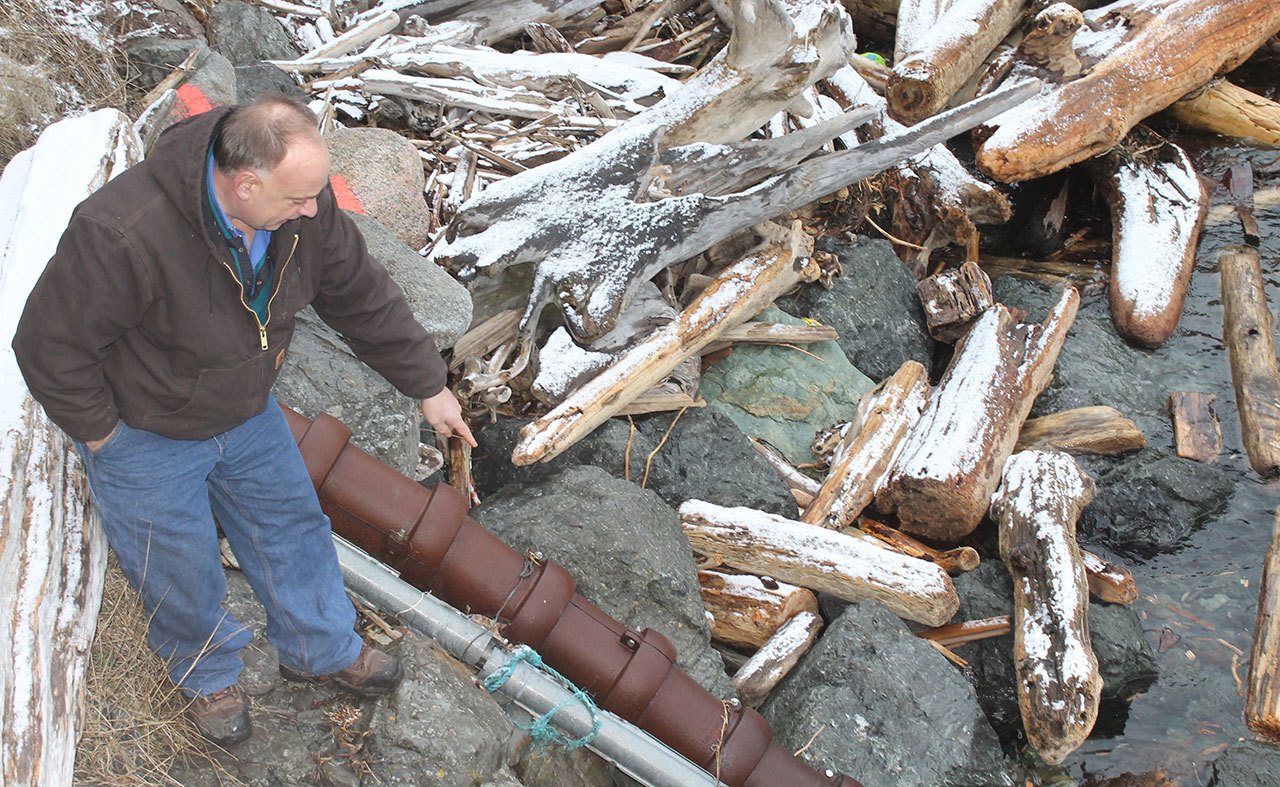OPALCO Systems Engineer Joel Mietzner looked down the bank off Pear Point Road on San Juan Island on Feb. 3. He pointed to a pipe encasing an OPALCO submarine power cable and a CenturyLink fiber optic cable, as well as rope and wire attaching the two, outside the culvert.
“The two cables are really more like one now,” he said, as he pointed to floating logs, that could hit either cable and affect the other.
Mietzner brought up the issue during the public comment section of the Jan. 18 San Juan County Council meeting to notify the public of the issues he faces as project manager of that power cable’s replacement since 2010.
At the Jan. 30 county council meeting, OPALCO, Rock Island Communications and CenturyLink discussed their efforts to work together on the cable replacements this summer — first CenturyLink’s fiber cable, then OPALCO’s power.
“We are working pretty closely with OPALCO, as well as different agencies, to get our cable replaced,” said Robert Griffith, vice president of CenturyLink’s western region at the Jan. 30 meeting.
CenturyLink officials are replacing the same cable that caused the last major phone and internet outage on the islands in 2013. It was then that OPALCO engineers discovered the cable floating on top of OPALCO’s power cable, running from Lopez to San Juan.
OPALCO engineers have been planning to replace this power cable since 2010, as routine maintenance, said Mietzner.
Work can start on July 16 — a state regulation based on when newly hatched fish are far enough from the shore to start construction. Griffith estimated the job would take two weeks at the Jan. 30 council meeting, then OPALCO can start their replacement, which is scheduled for September.
If OPALCO workers pick up their power cable with CenturyLink’s cable on top, the strain of the CenturyLink’s cable attachments could snap one or both cables, said Mietzner.
“There’s nothing OPALCO can do to our cable that won’t affect CenturyLink’s,” he said.
When the Lopez-to-San-Juan, CenturyLink fiber cable broke in 1990, the replacement cable was moved closer to OPALCO’s cable near San Juan Island, said Mietzner. The relocation allowed CenturyLink to run its underwater fiber cable on the land’s utilities easement, designated for any utility, to connect to their fiber on San Juan.
“We’re doing a joint plan together. The reason we have to is because there’s a common easement. We’re stuck living together,” said Mietzner.
The same cable broke again in 99. When reinstalled, it was placed in OPALCO’s culvert on the same easement, without OPALCO’s permission. Doug Patterson, CenturyLink’s director of engineering and construction, told The Journal the two cables have been attached with rope and wire, under the metal pipe, since then.
“The ties weren’t placed to keep CenturyLink’s cable from breaking or moving,” said Patterson. “If those ties were removed, it wouldn’t have any impact on the integrity of the cable or it going anywhere.”
However, Patterson did not answer why the cables were attached.
It wasn’t until August 2016, that OPALCO engineers noticed rope, wire and, in some places, duct tape, attaching the two cables, outside the culvert. Patterson said those additional attachments were added when they installed a plastic covering to the uncovered parts of their cable.
“Their property is on ours,” said Mietzner. “I can’t untie them, or OPALCO, the members, the county, will be liable if there are damages.”
It was an emergency when the CenturyLink cable was installed in 1990, in its current location, and then again in 1999, but paperwork to lease a DNR easement was never finished.
“When the cable was placed in 99, CenturyLink applied for the easement with the DNR, however that process was never completed,” said Patterson. “We have been actively working with the DNR to ensure that we are 100 percent completed with our fiber optic cable that we are replacing.”
The DNR regulates where and when underwater submarine cables can be placed, as well as how many cables are allowed in an area and how buoyant cables should be anchored to the ground.
Mietzner said OPALCO officials have paid the DNR $12,000 for a 23-year lease for their underwater power cable from Lopez to San Juan.
This summer the cables will be replaced off Pear Point Road. Although the two companies will share an easement, no attachments will be placed, according to Patterson. He said the CenturyLink cables in that location will be underground by the end of 2017, instead of above ground, whether uncovered or in pipes. OPALCO’s two power cables in that location will be underground too, said Mietzner.
“We’re a CenturyLink consumer too,” said Mietzner. “These changes are good for everyone.”



